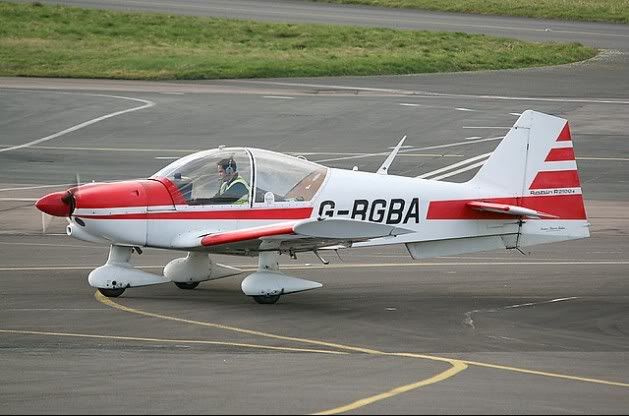The weather on Sunday was OK-ish. Quite gusty and varying from scattered but fairly well developed cumulus to near overcast. My lesson was at 16:00, so I made my way to the airfield in the afternoon. The weather looked good enough with a few large ‘holes’ in the cloud we could probably use.
Max arrived and gave me a longer briefing, but not spinning today, we would again concentrate on the basics, loop, roll and a few more stall turns. I had read the book he supplied and we discussed the ‘sacred circle’ that the nose of the aircraft describes relative to the horizon during a roll. A lot more discussion on rudder usage which ties back in to the primary and secondary effect of controls that I learned on the basic PPL – it really comes into its own here as we will be carrying out many moves at low airspeed and high engine power.

It was the older Robin 2100 this time, G-BGBA. I grabbed a checklist and did a proper ‘by the book’ walkaround. We emptied loose articles in the aircraft (a fuel drain tester loosely stowed in a semi-enclosed shelf would have made a nice missile rattling around the cockpit and would inevitably try to wedge itself in the root of the control stick!).
We climbed in and I started up, again by the book. It is always fun hunting around the panel for unfamiliar switches and uniquely French ways of doing things – this is only the second time I have flown a Robin, so a learning experience until things start to ‘fall to hand’. The aircraft was left half-full of fuel, which put us in the ‘aerobatics’ weight and balance category. So off we trundled.
I was conscious of the fact I was with an instructor, so I deliberately slowed my taxy speed down to the ‘officially approved’ fast walking pace – we all pick up bad habits and I guess a reasonably brisk taxy speed is a common one.
E2 for 22 was the hold as I did the power checks and pre-take off’s. ‘It’s not so much a rotate speed as it starts flying’ Max advised, warning again about avoiding Cessna type angles of attack close to the ground and the likelihood of a tailstrike in the Robin. So off we went, she picked up speed reasonably and as advertised, started to get ‘floaty’ then flew itself off. Climb at 75 kts to 300’ AGL then FEAT – Flaps, Engine, Attitude, Trim.
Climb at 75 kts on extended runway heading, so to the south west over Gloucester. I eventually got to a nice hole in the clouds at 4000’, pretty much over the ‘bends in the river’ on the Severn south-west of Gloucester. A good HASELLL check, transponder to 7004 and we are set to go.
First up is a ballistic roll to the left. This I do with the standard entry to 110 kts, stabalise then pull up to about 45 degrees, check to neutral pitch then ailerons fully over as the ground rotates around me. I looked carefully at the circle described by the nose of the aircraft, some of which was below the horizon. Roll out, regain 110, hard climb as speed bleeds back to 80 kts, then full power and nose down to a full power climb at 70 kts.
A few mistakes to work on. I am not quite getting the nose high enough to start, also I am not properly checking the pitch so enter the roll with back pressure and finally, rolling out a little too soon.
We do a few more over the space of the lesson and I pretty much get it all now, but not 100% yet on checking the pitch. I think it is a lack of confidence that I have attained the correct pitch. The way Max is teaching me is to stick with the basics until I have them through my head, then to ‘layer in’ other stuff until I put it all together. So once I have the ballistic roll off pat, I will go onto barrel roll’s and ailerons rolls and bring in the elements of rudder. Sounds like a good plan.
The loops were great fun. I started doing the pull up to vertical, then Max would take over and talk through what he was doing which I would mimic. By the end of the loops, I was doing all of the stick-work, but Max was still controlling the power. I have got the idea of looking at each wingtip on the pull-up and seem to be pulling up properly (i.e. not favouring one side or the other). I am looking up and over for the reappearance of the ground in the inverted. I have got the hang of easing back to near neutral in the inverted but I am maybe a bit slow to pull out in the vertical downwards.
I realise that Max is not troubling me with rudder inputs, as I can see the effect in the vertical of not doing this. I suspect he will cover this next time as he ‘layer more on’.
Max demonstrates the stall turn probably three or four times. There seems a fair bit to remember here, but I am starting to get the idea of what he is doing and hopefully I won’t cock it up too much when I try it.
Probably to test me out, Max gives me a mild dose of negative ‘G’ with a ‘half Cuban’ – with both of us suspended by the straps inverted for several seconds while bits of dirt and dead flies flutter ‘down’ to the top of the canopy – the quote from Top Gun occurs to me:
‘…….is this your idea of fun Mav?’
OK, this is hardly an F14, but you get the idea! Anyway, no problem with me with negative g.
Max asked me several times if I was OK and explained that repeated g forces make you tired and when tired, your concentration driops off and you learn less etc. I reassure him I am not the least bit tired (too much adrenaline) and I am fine with the g.
We head back to Gloucester and I take the plane for a standard overhead join for 22 and land off right hand circuits. The landing is pretty good and I keep a relatively shallow angle (as opposed to the normal ‘fully stalled’ landing) to avoid tailstrike. I think I am getting a feel for the aircraft, after all it is a pretty simple aircraft, it’s just where everything is and flying a stick as opposed to a yoke.
We taxy back and debrief. Next lesson, next Saturday at 16:00. If the weather is good, spins and if not, then a formal check-out on the type with PFL’s, steep turns, slow flight and circuits etc.
I only hope the weather holds for the next couple of months – probably a forlorn hope!
